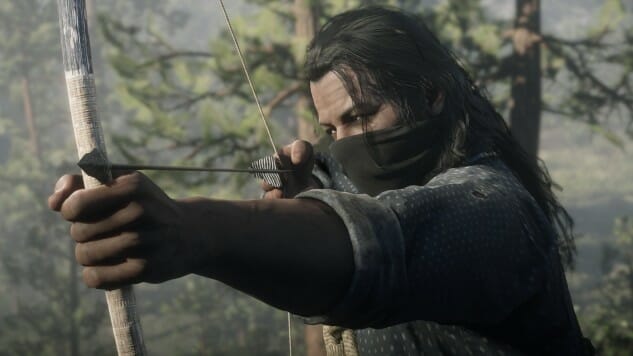It’s nearly the end of 2018, and I have to write an article about blackface and redface in Red Dead Redemption 2.
That sucks.
It sucks, because it means no one bothered to interrogate the casting. It sucks, because I know the pushback I’ll get for being the one to call out readily apparent racism in a game that opened to $725 million in sales. It sucks, because we’re still having to have conversations about why the perpetuation of racist stereotypes and the dehumanization of people of color is bad. It sucks, because didn’t we just do this with Uncharted: The Lost Legacy?
And it sucks, because I hoped maybe we could do better than Charles, and as a Native woman who got her start pleading with games journalists and developers to do better, I wouldn’t need to keep writing these articles.
Charles Smith has a Black father and a Native mother. He doesn’t know the name of his tribe, his father was an alcoholic, and his mother was taken by soldiers. Charles is grateful to find a group of white outlaws to accept him. He uses every part of the buffalo. Charles sucks. He’s another racist Rockstar caricature, and honestly that should be enough. But there’s another issue with Charles.
The actor who portrays him is neither Black nor Indigenous.
But, that’s complicated, because as is not infrequently the case with Native characters in films, he is a person of color.
The two other major Native characters in Rockstar’s cinematic Western labor abuse disaster are voiced by Graham Greene (Oneida) and Jeremiah Bitsui (Navajo/Omaha). Notable Black characters like Lenny, Tilly and Anthony are voiced by Black actors Harron Atkins, Meeya Davis and David St. Louis, respectively. Tatanka Means (Lakota/Dine) and David Midthunder (Lakota/Dakota/Nakota), among others, add their voices to the long list of incidental characters. Rockstar could have chosen any of these actors, the ones providing incidental voices, or literally any Black and/or Indigenous actor in this role, but they didn’t.
They cast Noshir Dalal, a Japanese and Parsi actor, who claims his being “pretty damn ethnically ambiguous” as a selling point, and that his “look” covers a wide-range of ethnicities. I don’t really blame Dalal. Playing into this ambiguity is what white supremacy in the fiercely competitive space of acting demands of marginalized people.
Blackface and redface have been an unfortunate constant, particularly in what is currently called America, for centuries. From its inseparability from 19th century American theater to later Hollywood films, (usually, but not exclusively) white actors have been pretending to be Black and Indigenous, typically as radically offensive stereotypes. Now, with digitally created characters, we’ve shifted from the makeup and costuming to their CG counterparts. Mocap actors inhabit and voice constructs of Blackness and Indigeneity. It’s a violence that continues to dehumanize and perpetuate racist ideas about people of color.
In addition to the usual violence of black or redface, what this “alternative” to whites performing in black and redface communicates that people of color are entirely interchangeable. That our lives and experiences and understandings are not unique, that we are merely “Other.” It perpetuates white supremacy. And, in a way, it’s worse than if they’d simply cast only white actors. Due to the casting of other Native and Black actors elsewhere in Red Dead Redemption 2, it communicates “We know better, we just don’t care.”
But, of course, it’s not merely that another AAA blockbuster did digital red and blackface. The problem is this kind of low-key racialized aggression doesn’t end with the act itself. This casting means a Black, Native (or, god forbid, a Black Native actor) didn’t get to play an actual Black Native role (and since Rockstar likes lesser known actors, a potential breakthrough role for them). They didn’t get to offer any feedback or help guide the role away from the regressive stereotypes present in the game, like Michael Greyeyes (Plains Cree) was afforded with 2006’s Prey. By not casting an Indigenous actor in the role, there was no real challenge to the racism in Houser’s story or characters, and that means that challenge has to come from us, from journalists, critics, gamers. And, well, it hasn’t been.
The most biting criticisms it received are about the labor conditions that created it, which is important and good. But in the month after those critiques, indigenous people have had to watch as this game, this character (and Dan Houser for creating him) are praised. And when literally any games critic or journalist could have written this piece, it’s once again up to me, the indigenous woman, to raise these issues alone. And there’s the equally inevitable silence from developers, journalists, and gamers themselves after this piece is chewed up and forgotten in the constant churn of games discourse.
It’s 2018, and I’m really tired of having to write this piece, the reasons I have to write it, and everything having to write it says about the world we live in.
Dia Lacina is a queer indigenous writer, photographer, and founding editor of CapsuleCrit.com, a monthly journal dedicated to microgenre work about games. She tweets too much at @dialacina.
